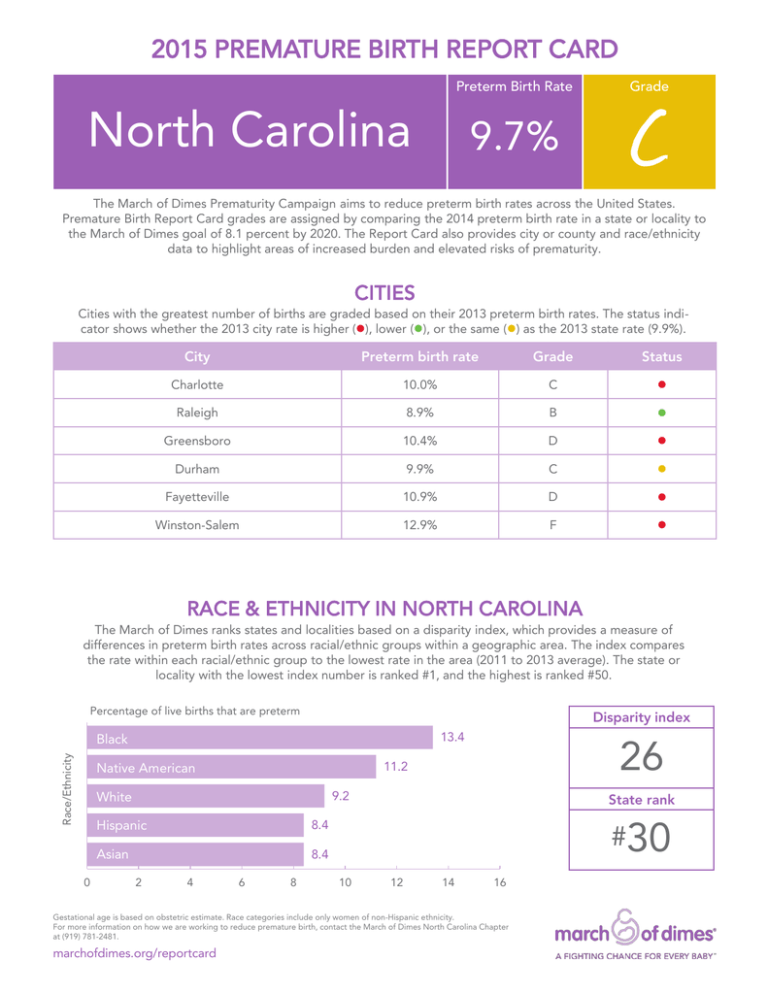a full report card for North Carolina
advertisement

2015 PREMATURE BIRTH REPORT CARD Preterm Birth Rate North Carolina 9.7% Grade C The March of Dimes Prematurity Campaign aims to reduce preterm birth rates across the United States. Premature Birth Report Card grades are assigned by comparing the 2014 preterm birth rate in a state or locality to the March of Dimes goal of 8.1 percent by 2020. The Report Card also provides city or county and race/ethnicity data to highlight areas of increased burden and elevated risks of prematurity. CITIES Cities with the greatest number of births are graded based on their 2013 preterm birth rates. The status indicator shows whether the 2013 city rate is higher (l), lower (l), or the same (l) as the 2013 state rate (9.9%). City Preterm birth rate Grade Status Charlotte 10.0% C l Raleigh 8.9% B l Greensboro 10.4% D l Durham 9.9% C l Fayetteville 10.9% D l Winston-Salem 12.9% F l RACE & ETHNICITY IN NORTH CAROLINA The March of Dimes ranks states and localities based on a disparity index, which provides a measure of differences in preterm birth rates across racial/ethnic groups within a geographic area. The index compares the rate within each racial/ethnic group to the lowest rate in the area (2011 to 2013 average). The state or locality with the lowest index number is ranked #1, and the highest is ranked #50. Percentage of live births that are preterm Disparity index 13.4 Race/Ethnicity Black 9.2 White 0 26 11.2 Native American Hispanic 8.4 Asian 8.4 2 4 6 8 State rank #30 10 12 14 16 Gestational age is based on obstetric estimate. Race categories include only women of non-Hispanic ethnicity. For more information on how we are working to reduce premature birth, contact the March of Dimes North Carolina Chapter at (919) 781-2481. marchofdimes.org/reportcard 2015 PREMATURE BIRTH REPORT CARD TECHNICAL NOTES PRETERM BIRTH: DEFINITION AND SOURCE Premature or preterm birth is birth less than 37 weeks gestation based on the obstetric estimate of gestational age. Data used in this report card come from the National Center for Health Statistics (NCHS) natality files, as compiled from data provided by the 57 vital statistics jurisdictions through the Vital Statistics Cooperative Program. This national data source is used so that data are comparable for each state- and jurisdiction-specific premature birth report card. Therefore, data provided on the report card may differ from data obtained directly from state or local health departments and vital statistics agencies, due to timing of data submission and handling of missing data. The preterm birth rate used to assign the grade shown at the top of the report card is from the NCHS 2014 final natality data. The city or county preterm birth rates and grades are calculated from the NCHS 2013 final natality data, while the preterm birth rates by race/ethnicity are calculated from the NCHS 2011-2013 final natality data. Preterm birth rates are calculated as the number of preterm births divided by the number of live births with known gestational age multiplied by 100. GRADING METHODOLOGY Grade ranges were established in 2015 based on standard deviations of final 2014 state and District of Columbia preterm birth rates away from the March of Dimes goal of 8.1% by 2020. Grades were determined using the following scoring formula: (preterm birth rate of each jurisdiction – 8.1%) / standard deviation of final 2014 state and District of Columbia preterm birth rates. The resulting scores were rounded to one decimal place and assigned a grade. See Table. Grade A Preterm birth rate less than or equal to 8.1% Score less than or equal to 0.0 B Preterm birth rate of 8.2% to 9.2% Score greater than 0.0, but less than or equal to 1.0 C Preterm birth rate of 9.3% to 10.3% Score greater than 1.0, but less than or equal to 2.0 D Preterm birth rate of 10.4% to 11.4% Score greater than 2.0, but less than or equal to 3.0 F Preterm birth rate greater than or equal to 11.5% Score greater than 3.0 SELECTION OF CITIES AND COUNTIES Report cards for jurisdictions with at least three cities of population of 100,000 or more, as defined in the 2013 NCHS natality file, display preterm birth rates for up to six cities. The cities shown represent those with the largest number of live births in that state, and are ordered accordingly. For states that do not have at least three cities with a population of 100,000 or more, up to six counties with the largest number of live births are displayed. Grades are assigned based on criteria described above. Preterm birth rate range Scoring criteria PRETERM BIRTH BY RACE/ETHNICITY OF THE MOTHER Race and Hispanic ethnicity are reported separately on the birth certificate. Rates for Hispanic women include all racial categories (white, black, Native American, Asian). Rates for non-Hispanic women are classified according to race. The Native American category includes American Indian or Alaska Native. The Asian category includes Asian or Pacific Islander and Native Hawaiian. In order to provide stable rates, three years of data were aggregated (2011-2013) and a numerator of 20 in each year (2011, 2012, 2013) was required for a category to appear on the report card. Preterm birth rates for not stated/unknown race are not shown on the report card. PRETERM BIRTH DISPARITY INDEX AND RANK The March of Dimes index of racial/ethnic disparity (“disparity index”) in preterm birth provides a measure of the differences, or disparities, in preterm birth rates across racial/ethnic groups within a geographic area. The index was developed by the March of Dimes Perinatal Data Center and is calculated for each U.S. state with adequate numbers, the District of Columbia and the total United States. To calculate the disparity index, the lowest preterm birth rate among the displayed racial/ethnic groups is identified for a geographic area and used as the comparison rate. The percent difference between the preterm birth rate and the comparison rate is calculated for each of the remaining racial/ethnic groups. The percent differences are then averaged to produce the index number, displayed as an integer. The disparity index number can be 0 or greater, with 0 representing no difference between groups. The unrounded index number for each geographic area is ranked against all other geographic areas, with the rank of #1 indicating the least disparity. CALCULATIONS All calculations were conducted by the March of Dimes Perinatal Data Center. marchofdimes.org/reportcard © 2015 March of Dimes Foundation




